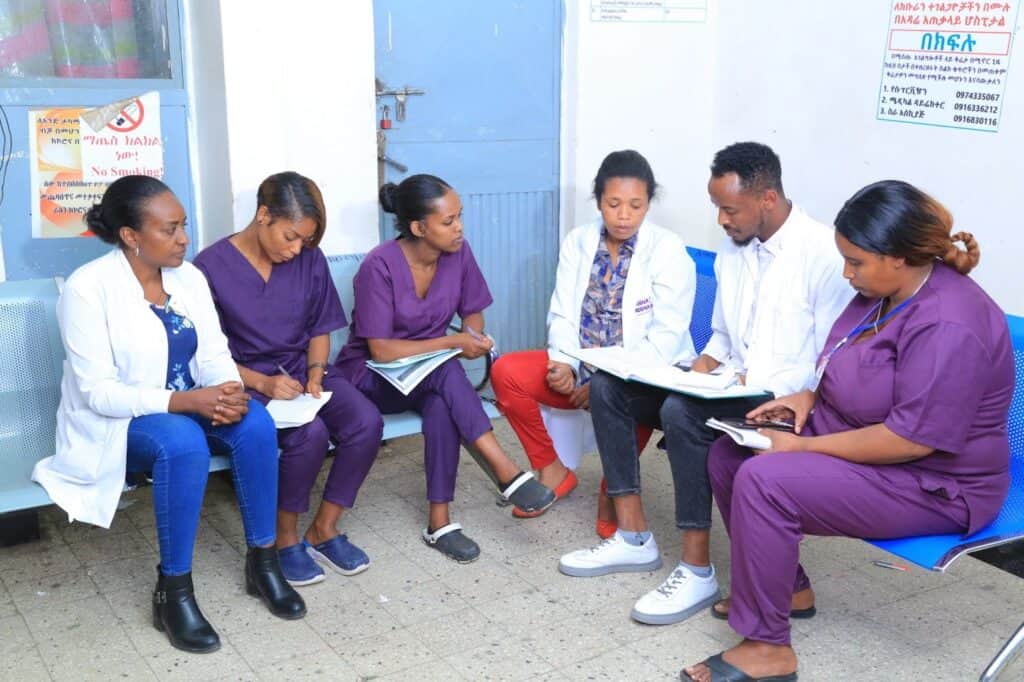Digital Harmony: How Ethiopia is Unifying Digital Systems for Better Health Outcomes
story
A HMIS worker reviews data on the DHIS 2 at Zewditu General Hospital: Credit: JSI Ethiopia
The health sector is burgeoning with new technology. Digitized client records, increased agility in supply chain with AI, and higher functioning health information systems are all enabling health programs to better respond to client needs. These tools and systems only improve care when they are harmonized: feeding each other data to create seamless information exchange. Lacking exchange, these systems operate like team members speaking different languages, using different tools, and refusing to share notes. Instead of making things easier, disparate systems can create more work for health providers and can lead to missed opportunities to provide quality, client-centered care.
Where timely, coordinated, and data-driven decisions can have life-saving implications – fragmented data leads to inefficiencies and missed opportunities to address client health needs. For digital health investments to yield their full potential, it is imperative that systems work in harmony.
Ethiopia has implemented a wide range of technology solutions across the national health sector to improve data collection and use, including the master facility register (MFR), a system that tracks every health clinic in the country, and an upgraded DHIS2, an open-source platform used to manage and analyze all health service use data. However, most solutions were launched independently and not created to interact with one another.

Health information technician loading data into DHIS2. Credit: JSI
The Ministry of Health (MOH) worked with JSI’s Gates Foundation-funded Data Use Partnership (DUP) project to strengthen interoperability, or the ability of digital solutions to work together, across a growing number of solutions. JSI, with various stakeholders, prioritized interoperability between MFR and DHIS2. By getting these two systems to “talk” to each other, for instance through consistent facility hierarchies, naming conventions, and coding systems, health facility staff and health sector leaders could more efficiently collect, analyze, and use data for decision-making purposes.
To start, JSI manually mapped and verified health care facilities, adding geolocation data for each. This helped identify “ghost facilities” that were no longer operational but continued to appear in the systems. Project staff worked with the MOH on policy-level alignment for facility inclusion criteria and to verify facility data. As a result, only operational facilities remain. The integration between MFR and DHIS2 now enables seamless access to standardized and up-to-date facility information across platforms, greatly enhancing consistency, health system efficiency, and decision-making at all levels.

Health workers at a major health center in Ethiopia gather for a meeting. Credit: JSI Ethiopia.
Though these systems were beginning to exchange consistent data, true interoperability was not yet achieved: users could not assign facilities to respective categories or data sets to facilities nor could they create user credentials for facilities in DHIS2 to enable facility use of the system. To address this, JSI developed an innovative solution known as the connector app.
The connector app automates several processes within DHIS2. These include assigning facilities to appropriate groups, creating users and user groups, and notifying system administrators of any changes in real-time. The app also supports a single-point data entry mechanism, which reduces inconsistencies, minimizes duplicate entries, and enhances the efficiency and reliability of the information generated and exchanged across the two solutions. The application enabled a true leap toward end-to-end interoperability: systems that not only communicate but also update and synchronize data together, automatically.
The successful interoperability between MFR and DHIS2 has translated into a significant improvement in the availability of complete, accurate, and timely health data. This integration also enhanced regulatory oversight. For instance, connecting facility license renewals to timely reporting encourages greater accountability and ensures facilities are compliant with reporting requirements and standards.
Ethiopian health leaders can now view service readiness and availability at a glance, quickly identifying gaps and deploying resources where they are most needed. Interoperability between MFR and DHIS2 enables more transparent, responsive, and data-driven health system management – laying a stronger foundation for improved service delivery and access, smarter planning, efficient resource use, and better health outcomes.
We strive to build lasting relationships to produce better health outcomes for all.